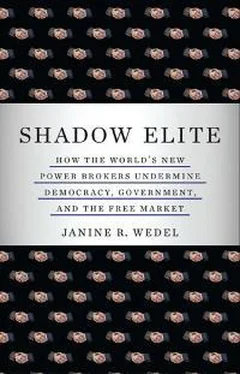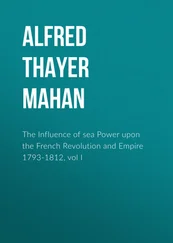12. For Schroeder’s position, see see: Craig Whilock and Peter Finn, “Schroeder Accepts Russian Pipeline Job,” The Washington Post , December 10, 2005, http://www.washingtonpost.com/wp-dyn/content/article/2005/12/09/AR2005120901755.html.
13. In the fall of 2008, after the failure of Lehman Brothers brought credit markets to their knees, banks found political connections more precious than ever. With American investment banks in free fall, the most politically connected seemed to land on the padded mattress of the TARP program, while their competitors received the concrete blow of forced mergers. Thomas B. Edsell of the Huffington Post is among those who have pointed out that it was a Lehman competitor, Goldman Sachs, that benefited most from the bailout of the insurance giant American International Group (AIG). Goldman Sachs was the largest beneficiary of AIG’s government sponsored life support—$12.6 billion. The key decision maker on these matters was Treasury Secretary Henry Paulson, the former CEO of Goldman Sachs. In fact, Goldman has taken significant advantage of government funds. As Edsell has written: “On November 25, 2008, Goldman became the first bank in the nation to benefit from the Federal Deposit Insurance Corp.’s Temporary Liquidity Guarantee Program (TLGP) . . . All told, Goldman has issued a total of $20 billion in government-guaranteed debt under TLGP. In their dealings with banks, both Treasury and the Fed have been subject to relatively minimal disclosure, in order to protect the proprietary interests of financial institutions, especially to prevent rumors of illiquidity or excessive debt from threatening a bank’s viability.” Thomas B. Edsall, “AIG Bonus Bombshell Raises New Questions about Goldman Sachs,” Huffington Post , April 2, 2009, http://www.huffingtonpost.com/2009/03/17/goldman-sachs-goes-for-th_n_175638.html. See also Lila Rajiva, “Three-Card Capitalists: The Financial Disappearing Act of 2008,” LewRockwell.com, October 1, 2008, http://www.lewrockwell.com/rajiva/rajiva11.html.
14. Investigative reporter John B. Judis has unearthed many of the facts of Jackson’s activities. See John B. Judis, “Minister Without Portfolio,” The American Prospect, Inc . 14, no. 5 (April 30, 2003), http://www.prospect.org/cs/articles?article=minister_without_portfolio. See also Jackson’s bio at the Project for the New American Century, http://www.newamericancentury.org/brucejacksonbio.htm.
With regard to Lockheed Martin as the largest federal contractor, as of 2006, the company was the largest defense contractor by revenue (http://www.defensenews.com/static/features/top100/charts/rank_2007.php?c=FEA&s=T1C) and “the largest provider of IT services, systems integration, and training to the U.S. Government,” according to the company (http://www.lockheedmartin.com/aboutus/index.html). See also Scott Shane and Ron Nixon, “In Washington, Contractors Take on Biggest Role Ever,” New York Times , February 4, 2007, p. A1; and Dana Hedgpeth, “Balancing Defense and the Budget After Eight Boom Years for Spending on Military Equipment, Contractors Expect a Slowdown,” Washington Post , October 13, 2008, p. D01, http://www.washingtonpost.com/wp-dyn/content/article/2008/10/12/AR2008101201724_pf.html. Lockheed Martin’s Web site states: “As a global security and information technology company, the majority of Lockheed Martin’s business is with the U.S. Department of Defense and the U.S. federal government agencies. The remaining portion of Lockheed Martin’s business is comprised of international government and some commercial sales of our products, services and platforms.” See http://www.lockheedmartin.com/aboutus/index.html.
15. Judis, “Minister Without Portfolio.” For perspectives on costs faced by new entrants to NATO, see John Laughland, “The Prague Racket,” The Guardian , November 22, 2002, http://www.guardian.co.uk/comment/story/0,3604,845129,00.html.
For signatories of the original (June 3, 1997) statement of principles of the Project for the New American Century, see: http://www.newamericancentury.org/statementofprinciples.htm. For Jackson’s role as project director, see http://www.newamericancentury.org/aboutpnac.htm.
16. For Jackson’s congressional testimony, see Bruce Pitcairn Jackson, “Testimony before the Senate Foreign Relations Committee,” April 1, 2003, http://www.globalsecurity.org/military/library/con-gress/2003_hr/jacksontestimony030401.pdf. See also F. William Engdahl, “The Emerging Russian Giant Plays its Cards Strategically,” Geopolitics–Geoeconomics , http://www.engdahl.oilgeopolitics.net/Geopolitics_Eurasia/Russian_Giant/russian_giant.html. The “Vilnius Ten” consisted of Albania, Bulgaria, Croatia, Estonia, Latvia, Lithuania, Macedonia, Romania, Slovakia, and Slovenia. The text consists of a “Statement of the Vilnius Group Countries in Response to the Presentation by the United States Secretary of State to the United Nations Security Council Concerning Iraq,” February 5, 2003. See “Vilnius Group Response to Powell UNSC Presentation on Iraq,” America.gov, February 7, 2009, http://www.america.gov/st/washfile-english/2003/February/20030207173228lfenner@pd.state.gov0.5013697.html. The source of Jackson’s role is Judis, “Minister Without Portfolio.” In 2003, Jackson shut the doors of both the Iraq and NATO committees. However, in the same set of offices, he and his colleagues launched a new undertaking, the Project on Transitional Democracies, another neoconservative-sponsored organization. See Engdahl, “The Emerging Russian Giant.”
17. For Kelman’s “evolving door,” see, for example, Steven Kelman, “Evolving Door,” Government Executive Magazine 36, no. 4 (March 16, 2004), http://www.govexec.com/features/0304/0304view.htm. For a profile of Kelman, see Forbes.com, “Steven Kelman Profile,” http://people.forbes.com/profile/steven-kelman/38757.
18. Kelman also led support for the Federal Acquisition Streamlining Act of 1994 (FASA) and the Federal Acquisition Reform Act of 1995 (FARA). See “Steven Kelman,” http://www.hks.harvard.edu/about/faculty-staff-directory/steven-kelman.
For Kelman’s views, see, for instance, the front flap of his 1990 book, as follows: “Requirements intended to promote competition in contracting have made the performance of government worse, not better, according to Professor Kelman. Using federal procurement of computer systems as his model, Kelman shows the devastating effects of practices designed to prevent collusion between vendors and officials.” Steven Kelman, Procurement and Public Management: The Fear of Discretion and the Quality of Government Performance (Washington, DC: American Enterprise Institute Press, 1990).
19. The advisory body Kelman sat on was the Defense Science Board Task Force. The press release is from the Bureau of National Affairs, “Gansler Asks Defense Science Board Group to Identify DOD Policies and Practices That Weaken Health, Competitiveness of U.S. Defense Industry,” Federal Contracts Report 73, no. 4 (Jan. 25, 2000), p. 105. The board’s final briefing is available at Defense Science Board Task Force, “Preserving a Healthy and Competitive U.S. Defense Industry to Ensure our Future National Security,” November, 2000, http://www.dtic.mil/cgi-bin/GetTRDoc?AD=ADA399865&Location=U2&doc=GetTRDoc.pdf.
The name of the company referred to here is GTSI Corporation. For information about Kelman’s role with GTSI, see “Investor Relations—Corporate Governance Biography,” http://investor.gtsi.com/phoenix.zhtml?c=116604&p=irol-govBio&ID=58294. According to GTSI’s Web site, “GTSI has provided technology products, professional services, and IT infrastructure solutions to federal, state, and local government.” For GTSI company information, see “About GTSI,” http://www.gtsi.com/cms/aboutgtsi/aboutdefault.aspx?ShopperID=36238be2–88b0–4856–8e7a-64993d5ec6fc. For GTSI’s annual sales, see their Securities and Exchange Commission Form 10-K, GTSI Corp. Commission File Number 0–19394, for the fiscal year ending December 31, 2008, Part I, http://www.sec.gov/Archives/edgar/data/850483/000136231009003216/c82046e10vk.htm#101. See also Forbes.com, “Steven Kelman Profile,” http://people.forbes.com/profile/steven-kelman/38757.
Читать дальше












